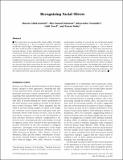Recognizing Facial Slivers
Author(s)
Gilad-Gutnick, Sharon; Harmatz, Elia Samuel; Tsourides, Kleovoulos; Yovel, Galit; Sinha, Pawan
DownloadPublished version (4.230Mb)
Terms of use
Metadata
Show full item recordAbstract
We report here an unexpectedly robust ability of healthy human individuals (n = 40) to recognize extremely distorted needle-like facial images, challenging the well-entrenched notion that veridical spatial configuration is necessary for extracting facial identity. In face identification tasks of parametrically compressed internal and external features, we found that the sum of performances on each cue falls significantly short of performance on full faces, despite the equal visual information available from both measures (with full faces essentially being a superposition of internal and external features). We hypothesize that this large deficit stems from the use of positional information about how the internal features are positioned relative to the external features. To test this, we systematically changed the relations between internal and external features and found preferential encoding of vertical but not horizontal spatial relationships in facial representations (n = 20). Finally, we employ magnetoencephalography imaging (n = 20) to demonstrate a close mapping between the behavioral psychometric curve and the amplitude of the M250 face familiarity, but not M170 face-sensitive evoked response field component, providing evidence that the M250 can be modulated by faces that are perceptually identifiable, irrespective of extreme distortions to the face’s veridical configuration. We theorize that the tolerance to compressive distortions has evolved from the need to recognize faces across varying viewpoints. Our findings help clarify the important, but poorly defined, concept of facial configuration and also enable an association between behavioral performance and previously reported neural correlates of face perception.
Date issued
2018-05Department
Massachusetts Institute of Technology. Department of Brain and Cognitive SciencesJournal
Journal of Cognitive Neuroscience
Publisher
MIT Press - Journals
Citation
Gilad-Gutnick, Sharon et al. "Recognizing Facial Slivers." Journal of Cognitive Neuroscience 30, 7 (July 2018): 951-962 © 2018 Massachusetts Institute of Technology.
Version: Final published version
ISSN
0898-929X
1530-8898
Keywords
Cognitive Neuroscience